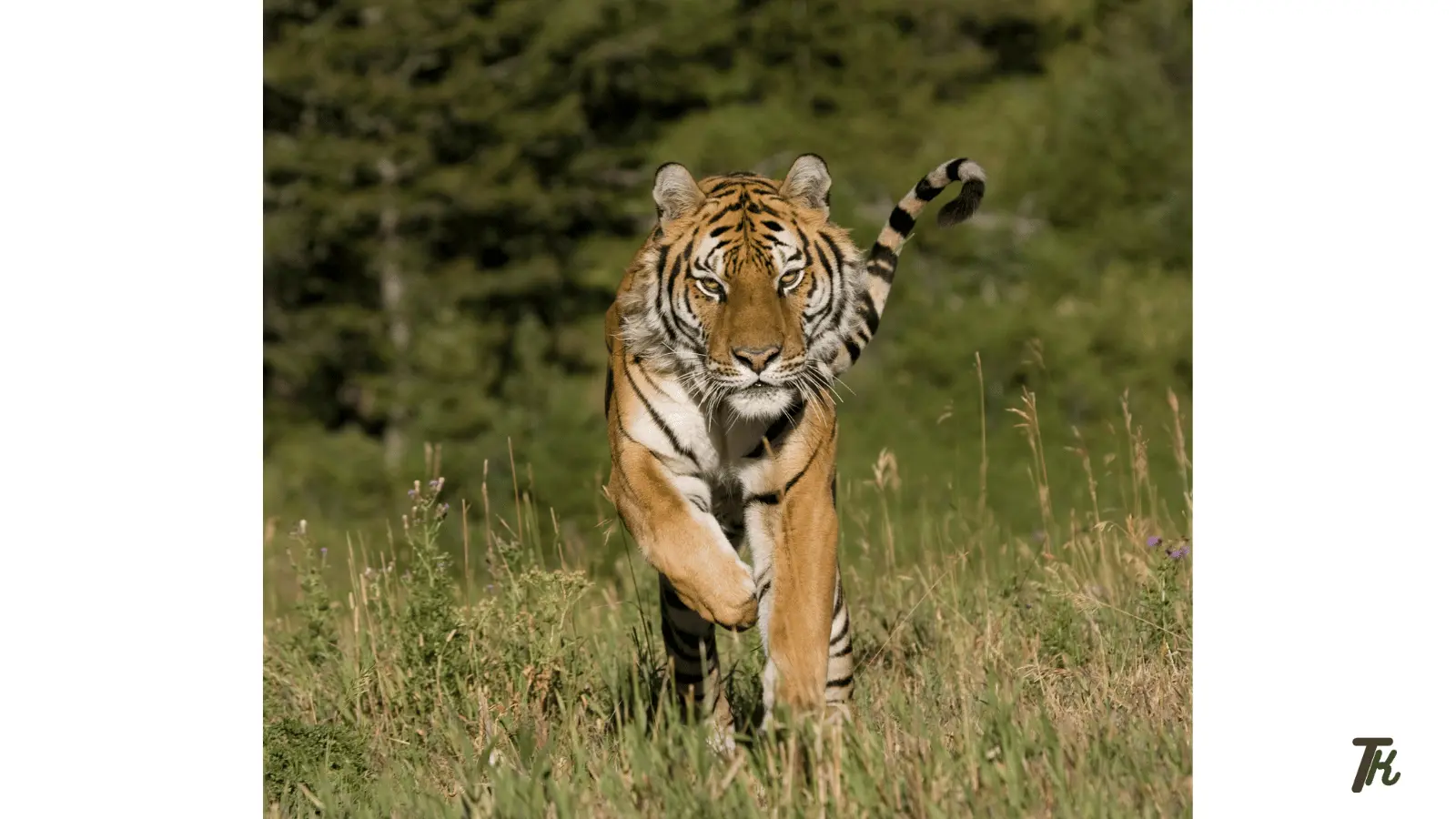As an Amazon Associate, I earn from qualifying purchases.
A tiger can run at speeds of up to 60 kilometers per hour and This article from the teamkathycarter website discusses How Fast Can a Tiger Run? This incredible speed allows tigers to effectively hunt their prey in the wild.
Tigers are awe-inspiring creatures known for their strength, agility, and raw power. One of the most remarkable characteristics of these majestic felines is their incredible speed. A tiger can reach speeds of up to 60 kilometers per hour, making them one of the fastest land animals on the planet.
This exceptional agility and swiftness enable tigers to pursue and capture their prey with remarkable efficiency. In this blog, we will explore the fascinating world of tiger running speed, shedding light on the factors that contribute to their remarkable swiftness and the implications of this ability in the wild. Join us as we delve into the remarkable world of tiger locomotion and the astounding speeds at which these magnificent creatures can sprint.

Credit: tiger-universe.com
The Majesty Of Tigers
Tigers, known for their majestic presence, can sprint at speeds of up to 60 km/h, making them formidable predators in the wild. Their agility and acceleration help them swiftly chase down prey during hunts. Witnessing a tiger in full stride is a breathtaking display of power and grace.
Physical Attributes
Tigers are magnificent creatures, known for their incredible physical attributes. Their majestic appearance and powerful build make them one of the most awe-inspiring animals on the planet. Let’s delve into the fascinating details of a tiger’s physical characteristics.
Species Variations
Tigers belong to the Panthera genus and are further classified into different species, each with its own unique characteristics. Here are some notable species variations:
| Species | Size | Weight | Coat Pattern |
|---|---|---|---|
| Bengal Tiger | 9-10 feet | 400-550 pounds | Orange coat with black stripes |
| Siberian Tiger | 10-12 feet | 500-700 pounds | Thicker coat, pale orange with black stripes |
| Sumatran Tiger | 7-8 feet | 220-310 pounds | Dark orange coat with narrow stripes |
Tigers display remarkable diversity in their size, weight, and coat patterns, adapting to their respective habitats. These variations add to their allure and make them even more captivating.
So, if you ever find yourself wondering about the physical attributes and species variations of tigers, refer to this guide to gain a deeper appreciation for these majestic creatures.
Measuring Speed
Tools And Techniques
Scientists use a variety of tools and techniques to measure the speed of tigers and other animals. One common method is the use of high-speed cameras, which capture the animal’s movement in slow motion, allowing researchers to calculate the speed based on the distance covered over a specific time period.
Comparative Analysis
Comparing the speed of tigers to other animals provides valuable insights. By analyzing the comparative speed of tigers with that of other predators such as lions, cheetahs, and leopards, researchers can gain a deeper understanding of the tiger’s hunting capabilities and overall agility.
Tiger Speed In The Wild
Tigers are renowned for their incredible speed and agility in the wild. With their powerful muscles and long strides, these majestic creatures can reach impressive speeds in pursuit of their prey. Understanding the tiger’s speed and its impact on hunting techniques and the terrain it inhabits provides valuable insight into their survival strategies.
Hunting Techniques- How Fast Can a Tiger Run?
Tigers employ a variety of hunting techniques to capture their prey. Their speed plays a crucial role in these strategies, allowing them to surprise and overpower their victims. When stalking their prey, tigers utilize their stealth and patience, moving silently through the underbrush. Once they spot a potential target, they rely on their explosive speed to launch a swift and precise attack, often covering significant distances in a matter of seconds.
When hunting larger prey such as deer or wild boar, tigers employ a different approach. They rely on their exceptional speed to close the gap between themselves and their quarry, using their strong hind legs to propel them forward. With a combination of speed and agility, tigers are able to quickly outmaneuver their prey, making it difficult for their victims to escape.
Terrain Impact- How Fast Can a Tiger Run?
The tiger’s speed is influenced by the terrain it navigates in the wild. These magnificent creatures are adaptable and can traverse various landscapes with ease. In open grasslands and savannahs, tigers can reach their maximum speeds, utilizing their long strides to cover ground quickly.
However, in dense forests and jungles, the tiger’s speed may be somewhat hindered. The thick vegetation and uneven terrain present challenges for these big cats, requiring them to adjust their hunting techniques accordingly. Despite these obstacles, tigers are still incredibly agile in such environments, using their muscular bodies to navigate through dense foliage and make swift turns when pursuing their prey.
Overall, the tiger’s speed in the wild is a remarkable attribute that contributes to their prowess as hunters. Whether sprinting across open plains or maneuvering through dense forests, these majestic creatures are capable of reaching impressive speeds, making them formidable predators in their natural habitat.
Bursts Of Speed- How Fast Can a Tiger Run?
Tigers are known for their bursts of speed, with the ability to run up to 60 km/h (37 mph) in short bursts. They are ambush predators and rely on their quick bursts of speed to catch their prey.
Short Distance Sprints
Tigers are known for their impressive bursts of speed, capable of reaching incredible velocities in a matter of seconds. When it comes to short distance sprints, these majestic creatures are true sprinters. A tiger can accelerate from a standstill to a breathtaking speed of up to 35 miles per hour (56 kilometers per hour) in just a few bounds.
Endurance Considerations- How Fast Can a Tiger Run?
While tigers possess remarkable acceleration and speed, their endurance is a different matter. Unlike marathon runners, tigers are not built for prolonged chases. Their bursts of speed are short-lived, typically lasting for only a few hundred meters before they need to slow down and catch their breath.
Despite their limited endurance, tigers strategically utilize their bursts of speed to their advantage. When hunting, they rely on quick sprints to close the gap between them and their prey, using their explosive acceleration to launch a surprise attack. This sprint-and-ambush strategy allows tigers to maximize their chances of a successful hunt.
It’s important to note that a tiger’s ability to sprint is not solely dependent on its physical prowess. Factors such as terrain, prey availability, and the individual tiger’s health and age can also influence their speed and endurance. Nevertheless, even with these variables, tigers remain one of the fastest land animals, showcasing their incredible agility and power.
Factors Affecting Speed- How Fast Can a Tiger Run?
Tigers can reach speeds of up to 40 to 50 miles per hour, making them one of the fastest land animals. Factors affecting their speed include their muscular build, long strides, and powerful hind limbs, enabling them to chase down prey with agility and precision.
When it comes to speed, tigers are one of the fastest animals in the world. They are powerful and agile, with the ability to run at incredible speeds. However, there are several factors that affect how fast a tiger can run. Let’s take a closer look at some of these factors.
Age And Health
The age and health of a tiger can have a significant impact on its speed. Younger tigers are generally faster and more agile than older tigers. As tigers age, their muscles may weaken, which can slow them down. Additionally, tigers that are sick or injured may not be able to run as fast as healthy tigers.
Environmental Influences- How Fast Can a Tiger Run?
The environment in which a tiger lives can also affect its speed. Tigers that live in areas with dense vegetation may not be able to run as fast as those that live in open areas. Similarly, tigers that live in colder climates may not be able to run as fast as those that live in warmer climates. In addition, factors such as wind and rain can also impact a tiger’s speed.
In conclusion, while tigers are known for their incredible speed, there are several factors that can affect how fast they can run. Age, health, and environmental influences all play a role in a tiger’s speed. It’s important to consider these factors when studying or observing tigers in the wild.
Credit: www.quora.com
Tigers Vs. Other Big Cats- How Fast Can a Tiger Run?
Tigers are known for their incredible speed, capable of running up to 40-50 miles per hour. This makes them one of the fastest big cats, surpassing the speed of lions, leopards, and cheetahs. Their agility and power give them a distinct advantage when hunting and capturing prey in the wild.
Cheetahs: The Speed Champions
Cheetahs are known for their exceptional speed, reaching up to 75 mph.
They are the fastest land animals on Earth, surpassing even tigers.
Lions And Leopards: A Comparison
Lions and leopards are also swift runners but not as fast as cheetahs.
Lions can run up to 50 mph, while leopards reach speeds of 36 mph.
Conservation Efforts
Tigers are incredible runners, capable of reaching speeds up to 40-50 miles per hour.
Habitat Preservation
Tiger habitats are crucial for their survival and must be protected from deforestation and human encroachment.
The Role Of Zoos
Zoos play a key role in tiger conservation through breeding programs and public awareness initiatives.

Credit: medium.com
Human Encounters- How Fast Can a Tiger Run?
The tiger is one of the fastest land animals, reaching speeds of up to 60 kilometers per hour (37 mph) in short bursts. This incredible speed allows them to quickly pursue and capture their prey, making them formidable hunters in their natural habitat.
Safety Precautions- How Fast Can a Tiger Run?
When encountering a tiger, follow these safety guidelines:
- Stay calm and back away slowly.
- Avoid direct eye contact with the tiger.
- Do not turn your back and run.
Respectful Observation- How Fast Can a Tiger Run?
Observe tigers from a safe distance to admire their beauty and power:
- Use binoculars or a zoom lens for a closer look.
- Respect their natural habitat and do not disturb them.
- Keep a safe distance to avoid provoking the tiger.
Frequently Asked Questions about How Fast Can a Tiger Run?
Could A Human Outrun A Tiger?
No, a human cannot outrun a tiger. Tigers are much faster and more agile than humans, with speeds of up to 35-40 miles per hour. It is best to avoid confrontation and seek safety rather than trying to outrun a tiger.
Can A Human Run Faster Than A Tiger?
No, humans cannot run faster than tigers. Tigers are one of the fastest land animals, with speeds reaching up to 60 km/h (37 mph), while the fastest human can only run up to 45 km/h (28 mph).
Which Is Faster, A Lion Or A Tiger?
Both the lion and the tiger are fast, but the tiger is generally faster.
What Is The Fastest A Tiger Can Run?
A tiger can run as fast as 60 miles per hour, making it one of the fastest land animals.
Last word about How Fast Can a Tiger Run?
The tiger’s exceptional speed enables it to reach up to 60 km/h, making it one of the fastest land animals. Understanding the tiger’s incredible agility and speed is crucial in appreciating its prowess as a top predator in the animal kingdom.
This knowledge enhances our overall understanding of these majestic creatures.
As an Amazon Associate, I earn from qualifying purchases.


